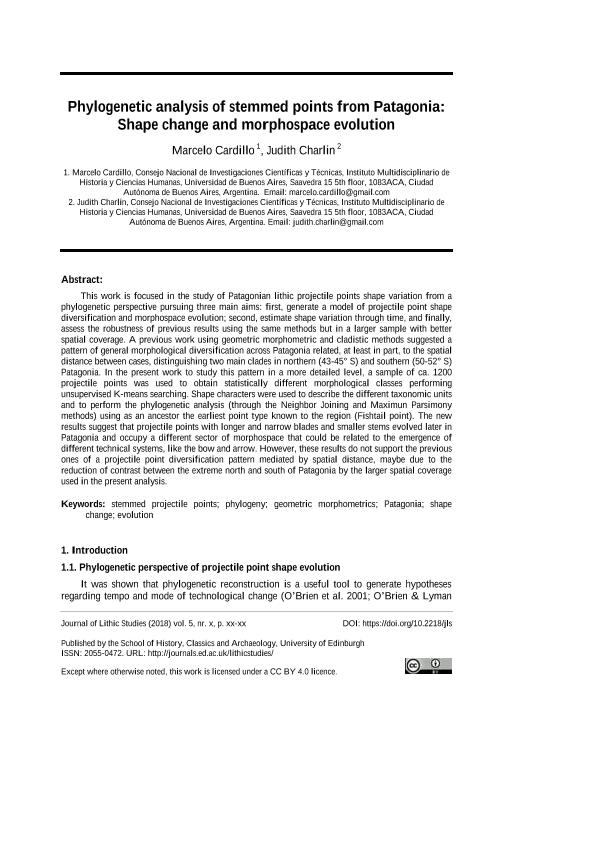Mostrar el registro sencillo del ítem
dc.contributor.author
Cardillo, Marcelo

dc.contributor.author
Charlin, Judith Emilce

dc.date.available
2019-10-10T18:15:48Z
dc.date.issued
2018-12
dc.identifier.citation
Cardillo, Marcelo; Charlin, Judith Emilce; Phylogenetic analysis of stemmed points from Patagonia: Shape change and morphospace evolution; University of Edinburgh; Journal of Lithic Studies; 5; 2; 12-2018; 1-32
dc.identifier.uri
http://hdl.handle.net/11336/85556
dc.description.abstract
This work is focused in the study of Patagonian lithic projectile points shape variation from a phylogenetic perspective pursuing three main aims: first, generate a model of projectile point shape diversification and morphospace evolution; second, estimate shape variation through time, and finally,assess the robustness of previous results using the same methods but in a larger sample with better spatial coverage. A previous work using geometric morphometric and cladistic methods suggested a pattern of general morphological diversification across Patagonia related, at least in part, to the spatial distance between cases, distinguishing two main clades in northern (43-45° S) and southern (50-52° S) Patagonia. In the present work to study this pattern in a more detailed level, a sample of ca. 1200 projectile points was used to obtain statistically different morphological classes performing unsupervised K-means searching. Shape characters were used to describe the different taxonomic unitsand to perform the phylogenetic analysis (through the Neighbor Joining and Maximun Parsimony methods) using as an ancestor the earliest point type known to the region (Fishtail point). The new results suggest that projectile points with longer and narrow blades and smaller stems evolved later in Patagonia and occupy a different sector of morphospace that could be related to the emergence ofdifferent technical systems, like the bow and arrow. However, these results do not support the previous ones of a projectile point diversification pattern mediated by spatial distance, maybe due to the reduction of contrast between the extreme north and south of Patagonia by the larger spatial coverage used in the present analysis.
dc.format
application/pdf
dc.language.iso
eng
dc.publisher
University of Edinburgh
dc.rights
info:eu-repo/semantics/openAccess
dc.rights.uri
https://creativecommons.org/licenses/by-nc-nd/2.5/ar/
dc.subject
STEMMED PROJECTILE POINTS
dc.subject
PHYLOGENY
dc.subject
GEOMETRIC MORPHOMETRICS
dc.subject
PATAGONIA
dc.subject.classification
Arqueología

dc.subject.classification
Historia y Arqueología

dc.subject.classification
HUMANIDADES

dc.title
Phylogenetic analysis of stemmed points from Patagonia: Shape change and morphospace evolution
dc.type
info:eu-repo/semantics/article
dc.type
info:ar-repo/semantics/artículo
dc.type
info:eu-repo/semantics/publishedVersion
dc.date.updated
2019-10-08T12:53:24Z
dc.identifier.eissn
2055-0472
dc.journal.volume
5
dc.journal.number
2
dc.journal.pagination
1-32
dc.journal.pais
Reino Unido

dc.description.fil
Fil: Cardillo, Marcelo. Consejo Nacional de Investigaciones Científicas y Técnicas. Oficina de Coordinación Administrativa Saavedra 15. Instituto Multidisciplinario de Historia y Ciencias Humanas; Argentina
dc.description.fil
Fil: Charlin, Judith Emilce. Consejo Nacional de Investigaciones Científicas y Técnicas. Oficina de Coordinación Administrativa Saavedra 15. Instituto Multidisciplinario de Historia y Ciencias Humanas; Argentina
dc.journal.title
Journal of Lithic Studies
dc.relation.alternativeid
info:eu-repo/semantics/altIdentifier/doi/http://dx.doi.org/10.2218/jls
dc.relation.alternativeid
info:eu-repo/semantics/altIdentifier/url/http://journals.ed.ac.uk/lithicstudies/article/view/2797
Archivos asociados
